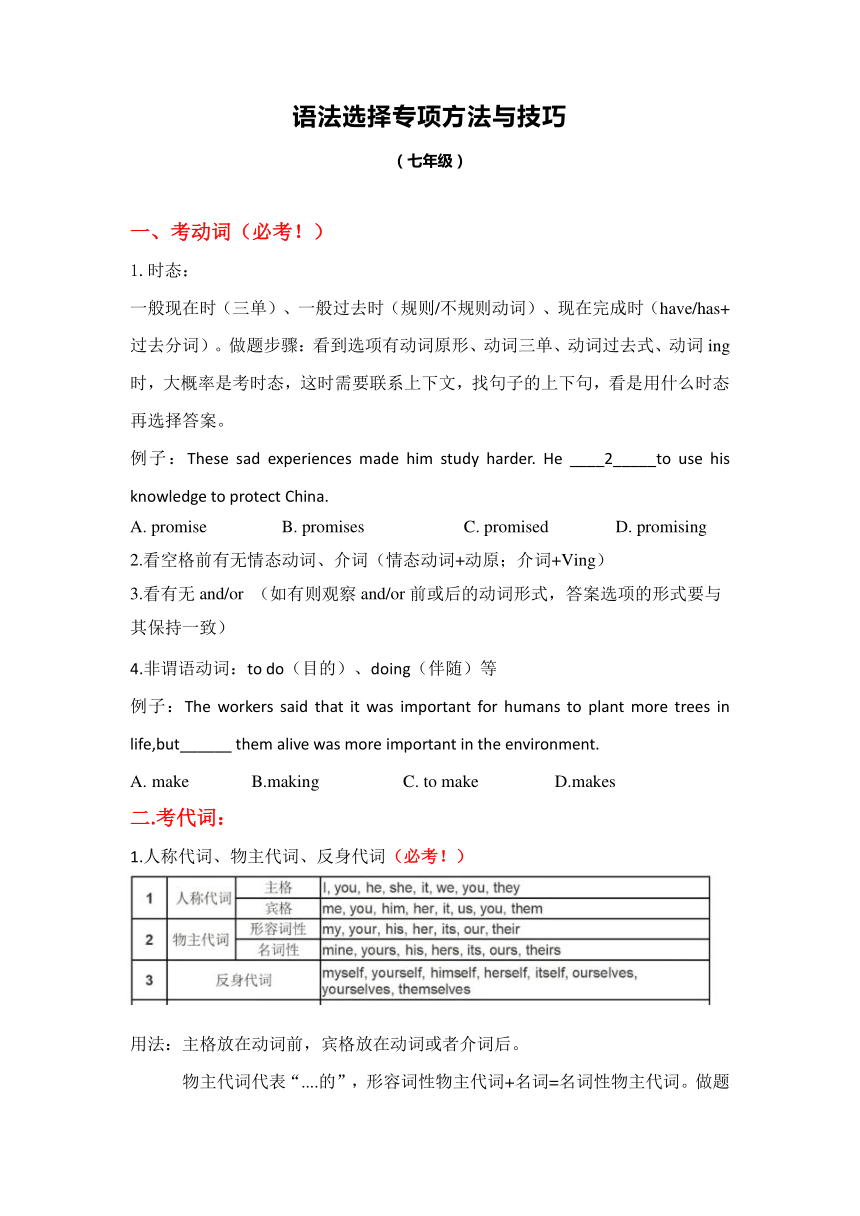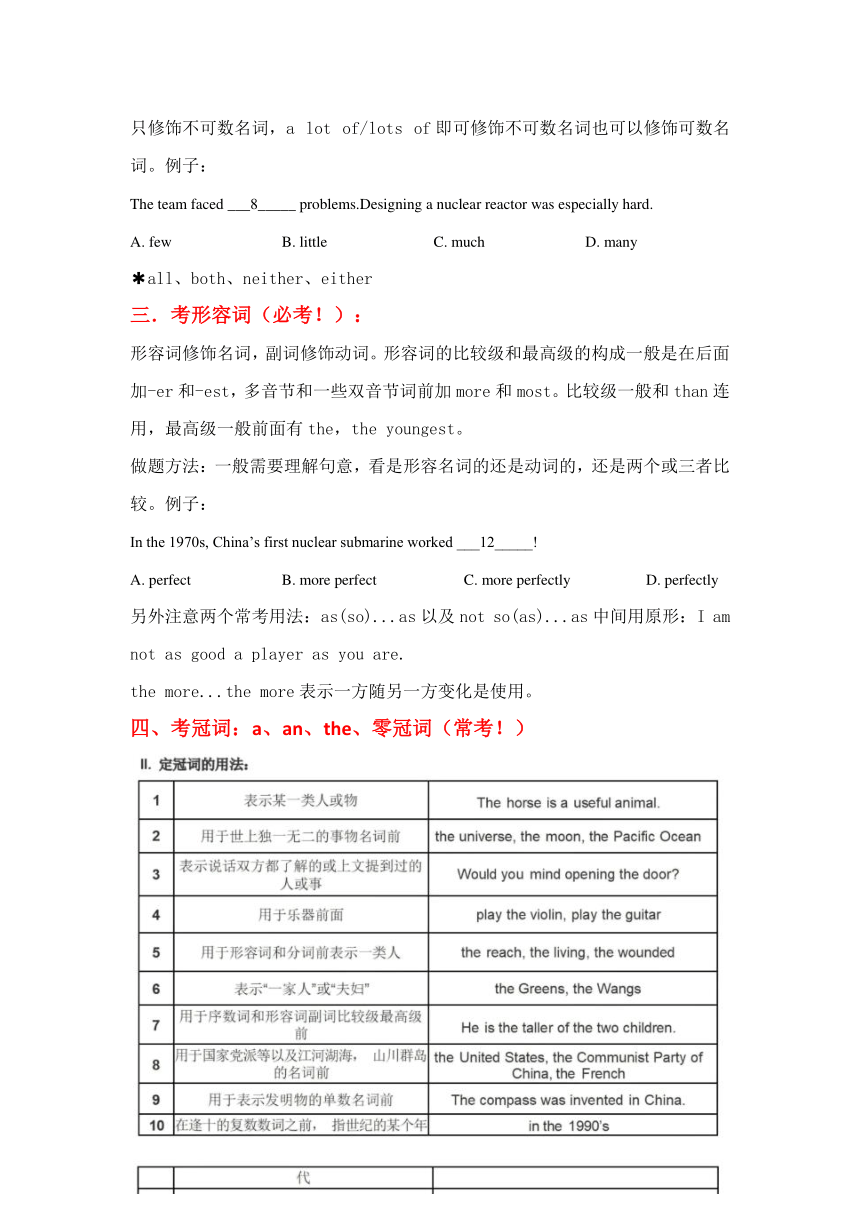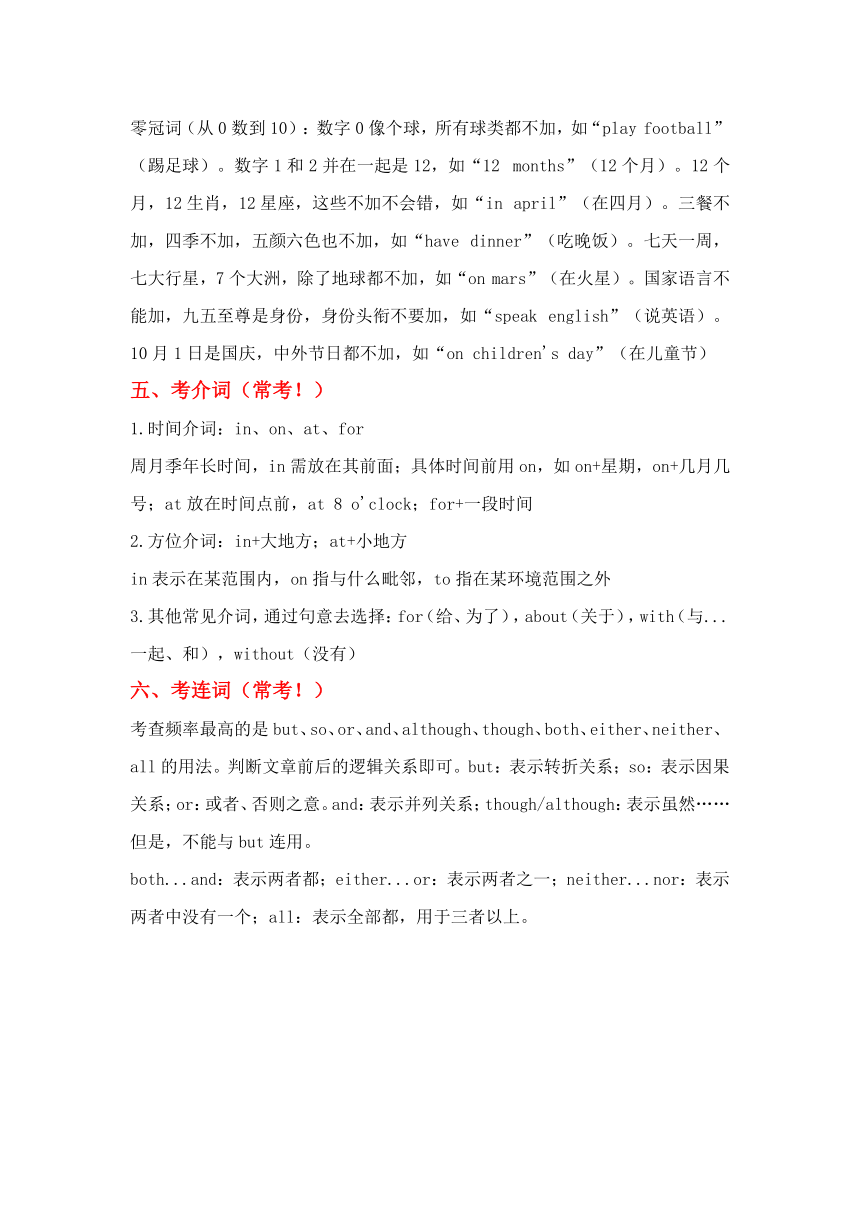期中语法选择专项方法与技巧 2024-2025学年沪教版(2024)七年级英语下册
文档属性
| 名称 | 期中语法选择专项方法与技巧 2024-2025学年沪教版(2024)七年级英语下册 |  | |
| 格式 | docx | ||
| 文件大小 | 268.3KB | ||
| 资源类型 | 教案 | ||
| 版本资源 | 沪教版 | ||
| 科目 | 英语 | ||
| 更新时间 | 2025-04-16 13:13:34 | ||
图片预览




文档简介
语法选择专项方法与技巧
(七年级)
一、考动词(必考!)
1.时态:
一般现在时(三单)、一般过去时(规则/不规则动词)、现在完成时(have/has+ 过去分词)。做题步骤:看到选项有动词原形、动词三单、动词过去式、动词ing时,大概率是考时态,这时需要联系上下文,找句子的上下句,看是用什么时态再选择答案。
例子:These sad experiences made him study harder. He ____2_____to use his knowledge to protect China.
A. promise B. promises C. promised D. promising
2.看空格前有无情态动词、介词(情态动词+动原;介词+Ving)
3.看有无and/or (如有则观察and/or前或后的动词形式,答案选项的形式要与其保持一致)
4.非谓语动词:to do(目的)、doing(伴随)等
例子:The workers said that it was important for humans to plant more trees in life,but______ them alive was more important in the environment.
make B.making C. to make D.makes
二.考代词:
1.人称代词、物主代词、反身代词(必考!)
用法:主格放在动词前,宾格放在动词或者介词后。
物主代词代表“....的”,形容词性物主代词+名词=名词性物主代词。做题时看需要选择的空有没有名词在后面。
反身代词为“....自己”,通常前面有介词by,或反身代词常考——enjoy oneself / help yourself / dress oneself / teach oneself。
例子:Today, Huang’s story teaches us to work hard, face difficulties bravely, and love ____14___ country.
we B. our C. ours D. ourselves
2.指示代词this、that、these、those:this是近的一个,that是远的一个,these是近的两个或以上,those是远的两个或以上
3.疑问代词who、whom、whose、which、what、whoever、whichever、whatever、how:通常需要根据句意去选择(常考!)
4.不定代词:
some与any:some多用于肯定句,any多用于疑问句和否定句
each和every:every强调全体的概念(指三个或以上),each强调个体概念(指两个或两个以上)
other、others、another、the other(常考!):other和others都是“其他的”,other+名词=others;another和the other都是“另一个”,但是another是指三个或以上的另一个,the other是两个的中的另一个,所以在题目中需要找出总的有多少个。例题:
The team faced many problems. Designing a nuclear reactor was especially hard. They could not ask foreign experts for help so they used simple tools like abacuses and rulers. They did thousands of experiments. ____11_____ big challenge was making the submarine stable underwater. After many tests, they finally solved these problems.
Other B. Another C. Others D. The other
5.a few、a little、few、little、many、much、a lot of/lots of(常考!):
a few 和a little是“有一点”,few和little是“几乎没有”,有few的都是修饰可数名词的,little都是修饰不可数名词的。
many、much、a lot of/lots of都代表许多,但是many只修饰可数名词,much只修饰不可数名词,a lot of/lots of即可修饰不可数名词也可以修饰可数名词。例子:
The team faced ___8_____ problems.Designing a nuclear reactor was especially hard.
few B. little C. much D. many
all、both、neither、either
三.考形容词(必考!):
形容词修饰名词,副词修饰动词。形容词的比较级和最高级的构成一般是在后面加-er和-est,多音节和一些双音节词前加more和most。比较级一般和than连用,最高级一般前面有the,the youngest。
做题方法:一般需要理解句意,看是形容名词的还是动词的,还是两个或三者比较。例子:
In the 1970s, China’s first nuclear submarine worked ___12_____!
A. perfect B. more perfect C. more perfectly D. perfectly
另外注意两个常考用法:as(so)...as以及not so(as)...as中间用原形:I am not as good a player as you are.
the more...the more表示一方随另一方变化是使用。
四、考冠词:a、an、the、零冠词(常考!)
零冠词(从0数到10):数字0像个球,所有球类都不加,如“play football”(踢足球)。数字1和2并在一起是12,如“12 months”(12个月)。12个月,12生肖,12星座,这些不加不会错,如“in april”(在四月)。三餐不加,四季不加,五颜六色也不加,如“have dinner”(吃晚饭)。七天一周,七大行星,7个大洲,除了地球都不加,如“on mars”(在火星)。国家语言不能加,九五至尊是身份,身份头衔不要加,如“speak english”(说英语)。10月1日是国庆,中外节日都不加,如“on children's day”(在儿童节)
五、考介词(常考!)
1.时间介词:in、on、at、for
周月季年长时间,in需放在其前面;具体时间前用on,如on+星期,on+几月几号;at放在时间点前,at 8 o'clock;for+一段时间
2.方位介词:in+大地方;at+小地方
in表示在某范围内,on指与什么毗邻,to指在某环境范围之外
3.其他常见介词,通过句意去选择:for(给、为了),about(关于),with(与...一起、和),without(没有)
六、考连词(常考!)
考查频率最高的是but、so、or、and、although、though、both、either、neither、all的用法。判断文章前后的逻辑关系即可。but:表示转折关系;so:表示因果关系;or:或者、否则之意。and:表示并列关系;though/although:表示虽然……但是,不能与but连用。
both...and:表示两者都;either...or:表示两者之一;neither...nor:表示两者中没有一个;all:表示全部都,用于三者以上。
考名词(常考!)
空格需要填名词。先看空格是否需要名词(特别需要留意动词和名词是同一个单词的词汇如work、water、cook、light.....),如果句子完整已有名词,那这个空格需要的是一个名词。在这里考的就是可数名词和不可数名词。一般情况下会有一些提示词例如many、much、few这些,可以帮助选择可数还是不可数。
例子:It has many world-famous 5 of art, such as the Mona Lisa.
A. work B. works C. working D. worked
空格需要填be动词。如果空格前是名词,就要判断名词是可数名词还是不可数名词。例子:The food 6 delicious!
A. am B. is C. was D. were
八、其他(句型、固搭等....)(常考!)
1.It's+形容词+(for sb)+to do sth
2.What和How引导的感叹句:
What+(a/an)+形容词+名词+主语+谓语!
How+形容词+主语+谓语!
3.excited/exciting、surprised/surprising、interested/interesting、bored/boring的用法:-ed是形容人的,-ing是形容人或者物的
4.stop to do和stop doing:stop to do sth是停止去做某事、stop doing是停止做某事
5.enjoy、like、love+动词ing
6.thousand、hundred的考法:基数词+hundred/thousand;hundreds/thousands of
7.sometime、sometimes、some time、some times:sometime是某个时候;sometimes有时;some time表示某段时间,常与for连用;some times几次
8.There be句型
9.情态动词can/could(能力/请求)、must/have to(必须)、should(应该)、may/might(可能),后接动词原形;
10.everyone 后接动词三单形式
11.People是复数形式,person是单数、persons是复数
12.encourage sb.to do sth.鼓励某人做某事
13.used to do sth过去常常做某事、get/be used to doing 习惯于...
14.be kind to:对..友善的= be friendly to
15.be patient with sb 对...有耐心
16.pay attention to+sth/doing sth 当心(注意这里不是to do而是to doing)
17.be strict about sth/be strict with sb
18.If引导的条件状语从句,主将从现,主情从现
19.be worried about 担心
20.arrive in(大地方),arrive at(小地方),get to、reach
21.such as、for example:such as 后跟单词或词组,for example后跟句子
22.be famous for=be known for 因...而出名,后接出名的原因
be famous as=be known as 作为....而出名,后接职业、身份、地位
23.prefer doing A to doing B/prefer to do A rather than do B宁愿做A事,也不愿意做B事
prefer to do sth宁愿/更喜欢做某事
24.go+动词ing
25.Why not do sth=Why don’t you do sth“为什么不...呢?”
26.share sth with sb 和某人分享某物
27.be made of 看得出原材料;be made from 看不出原材料(paper、pencil都是看不出原材料的)
28.apologize to sb向某人道歉
apologize for doing sth(因某事而道歉)
29.fall asleep入睡、feel sleepy犯困
30.somewhere、anywhere、everywhere、nowhere的用法:
somewhere“在某处”用于肯定句
anywhere“在任何地方”,用于疑、否句中
Everywhere“各个地方、各处”
nowhere“无处”
31.__________________________________________________________________
31.__________________________________________________________________
31.__________________________________________________________________
31.__________________________________________________________________
31.__________________________________________________________________
31.__________________________________________________________________
31.__________________________________________________________________
31.__________________________________________________________________
31.__________________________________________________________________
31.__________________________________________________________________
31.__________________________________________________________________
31.__________________________________________________________________
31.__________________________________________________________________
31.__________________________________________________________________
31.__________________________________________________________________
31.__________________________________________________________________
31.__________________________________________________________________
31.__________________________________________________________________
31.__________________________________________________________________
31.__________________________________________________________________
31.__________________________________________________________________
31.__________________________________________________________________
31.__________________________________________________________________
31.__________________________________________________________________
31.__________________________________________________________________
31.__________________________________________________________________
31.__________________________________________________________________
31.__________________________________________________________________
31.__________________________________________________________________
31.__________________________________________________________________
31.__________________________________________________________________
31.__________________________________________________________________
31.__________________________________________________________________
31.__________________________________________________________________
31.__________________________________________________________________
31.__________________________________________________________________
31.__________________________________________________________________
31.__________________________________________________________________
31.__________________________________________________________________
31.__________________________________________________________________
31.__________________________________________________________________
31.__________________________________________________________________
31.__________________________________________________________________
31.__________________________________________________________________
31.__________________________________________________________________
31.__________________________________________________________________
31.__________________________________________________________________
(七年级)
一、考动词(必考!)
1.时态:
一般现在时(三单)、一般过去时(规则/不规则动词)、现在完成时(have/has+ 过去分词)。做题步骤:看到选项有动词原形、动词三单、动词过去式、动词ing时,大概率是考时态,这时需要联系上下文,找句子的上下句,看是用什么时态再选择答案。
例子:These sad experiences made him study harder. He ____2_____to use his knowledge to protect China.
A. promise B. promises C. promised D. promising
2.看空格前有无情态动词、介词(情态动词+动原;介词+Ving)
3.看有无and/or (如有则观察and/or前或后的动词形式,答案选项的形式要与其保持一致)
4.非谓语动词:to do(目的)、doing(伴随)等
例子:The workers said that it was important for humans to plant more trees in life,but______ them alive was more important in the environment.
make B.making C. to make D.makes
二.考代词:
1.人称代词、物主代词、反身代词(必考!)
用法:主格放在动词前,宾格放在动词或者介词后。
物主代词代表“....的”,形容词性物主代词+名词=名词性物主代词。做题时看需要选择的空有没有名词在后面。
反身代词为“....自己”,通常前面有介词by,或反身代词常考——enjoy oneself / help yourself / dress oneself / teach oneself。
例子:Today, Huang’s story teaches us to work hard, face difficulties bravely, and love ____14___ country.
we B. our C. ours D. ourselves
2.指示代词this、that、these、those:this是近的一个,that是远的一个,these是近的两个或以上,those是远的两个或以上
3.疑问代词who、whom、whose、which、what、whoever、whichever、whatever、how:通常需要根据句意去选择(常考!)
4.不定代词:
some与any:some多用于肯定句,any多用于疑问句和否定句
each和every:every强调全体的概念(指三个或以上),each强调个体概念(指两个或两个以上)
other、others、another、the other(常考!):other和others都是“其他的”,other+名词=others;another和the other都是“另一个”,但是another是指三个或以上的另一个,the other是两个的中的另一个,所以在题目中需要找出总的有多少个。例题:
The team faced many problems. Designing a nuclear reactor was especially hard. They could not ask foreign experts for help so they used simple tools like abacuses and rulers. They did thousands of experiments. ____11_____ big challenge was making the submarine stable underwater. After many tests, they finally solved these problems.
Other B. Another C. Others D. The other
5.a few、a little、few、little、many、much、a lot of/lots of(常考!):
a few 和a little是“有一点”,few和little是“几乎没有”,有few的都是修饰可数名词的,little都是修饰不可数名词的。
many、much、a lot of/lots of都代表许多,但是many只修饰可数名词,much只修饰不可数名词,a lot of/lots of即可修饰不可数名词也可以修饰可数名词。例子:
The team faced ___8_____ problems.Designing a nuclear reactor was especially hard.
few B. little C. much D. many
all、both、neither、either
三.考形容词(必考!):
形容词修饰名词,副词修饰动词。形容词的比较级和最高级的构成一般是在后面加-er和-est,多音节和一些双音节词前加more和most。比较级一般和than连用,最高级一般前面有the,the youngest。
做题方法:一般需要理解句意,看是形容名词的还是动词的,还是两个或三者比较。例子:
In the 1970s, China’s first nuclear submarine worked ___12_____!
A. perfect B. more perfect C. more perfectly D. perfectly
另外注意两个常考用法:as(so)...as以及not so(as)...as中间用原形:I am not as good a player as you are.
the more...the more表示一方随另一方变化是使用。
四、考冠词:a、an、the、零冠词(常考!)
零冠词(从0数到10):数字0像个球,所有球类都不加,如“play football”(踢足球)。数字1和2并在一起是12,如“12 months”(12个月)。12个月,12生肖,12星座,这些不加不会错,如“in april”(在四月)。三餐不加,四季不加,五颜六色也不加,如“have dinner”(吃晚饭)。七天一周,七大行星,7个大洲,除了地球都不加,如“on mars”(在火星)。国家语言不能加,九五至尊是身份,身份头衔不要加,如“speak english”(说英语)。10月1日是国庆,中外节日都不加,如“on children's day”(在儿童节)
五、考介词(常考!)
1.时间介词:in、on、at、for
周月季年长时间,in需放在其前面;具体时间前用on,如on+星期,on+几月几号;at放在时间点前,at 8 o'clock;for+一段时间
2.方位介词:in+大地方;at+小地方
in表示在某范围内,on指与什么毗邻,to指在某环境范围之外
3.其他常见介词,通过句意去选择:for(给、为了),about(关于),with(与...一起、和),without(没有)
六、考连词(常考!)
考查频率最高的是but、so、or、and、although、though、both、either、neither、all的用法。判断文章前后的逻辑关系即可。but:表示转折关系;so:表示因果关系;or:或者、否则之意。and:表示并列关系;though/although:表示虽然……但是,不能与but连用。
both...and:表示两者都;either...or:表示两者之一;neither...nor:表示两者中没有一个;all:表示全部都,用于三者以上。
考名词(常考!)
空格需要填名词。先看空格是否需要名词(特别需要留意动词和名词是同一个单词的词汇如work、water、cook、light.....),如果句子完整已有名词,那这个空格需要的是一个名词。在这里考的就是可数名词和不可数名词。一般情况下会有一些提示词例如many、much、few这些,可以帮助选择可数还是不可数。
例子:It has many world-famous 5 of art, such as the Mona Lisa.
A. work B. works C. working D. worked
空格需要填be动词。如果空格前是名词,就要判断名词是可数名词还是不可数名词。例子:The food 6 delicious!
A. am B. is C. was D. were
八、其他(句型、固搭等....)(常考!)
1.It's+形容词+(for sb)+to do sth
2.What和How引导的感叹句:
What+(a/an)+形容词+名词+主语+谓语!
How+形容词+主语+谓语!
3.excited/exciting、surprised/surprising、interested/interesting、bored/boring的用法:-ed是形容人的,-ing是形容人或者物的
4.stop to do和stop doing:stop to do sth是停止去做某事、stop doing是停止做某事
5.enjoy、like、love+动词ing
6.thousand、hundred的考法:基数词+hundred/thousand;hundreds/thousands of
7.sometime、sometimes、some time、some times:sometime是某个时候;sometimes有时;some time表示某段时间,常与for连用;some times几次
8.There be句型
9.情态动词can/could(能力/请求)、must/have to(必须)、should(应该)、may/might(可能),后接动词原形;
10.everyone 后接动词三单形式
11.People是复数形式,person是单数、persons是复数
12.encourage sb.to do sth.鼓励某人做某事
13.used to do sth过去常常做某事、get/be used to doing 习惯于...
14.be kind to:对..友善的= be friendly to
15.be patient with sb 对...有耐心
16.pay attention to+sth/doing sth 当心(注意这里不是to do而是to doing)
17.be strict about sth/be strict with sb
18.If引导的条件状语从句,主将从现,主情从现
19.be worried about 担心
20.arrive in(大地方),arrive at(小地方),get to、reach
21.such as、for example:such as 后跟单词或词组,for example后跟句子
22.be famous for=be known for 因...而出名,后接出名的原因
be famous as=be known as 作为....而出名,后接职业、身份、地位
23.prefer doing A to doing B/prefer to do A rather than do B宁愿做A事,也不愿意做B事
prefer to do sth宁愿/更喜欢做某事
24.go+动词ing
25.Why not do sth=Why don’t you do sth“为什么不...呢?”
26.share sth with sb 和某人分享某物
27.be made of 看得出原材料;be made from 看不出原材料(paper、pencil都是看不出原材料的)
28.apologize to sb向某人道歉
apologize for doing sth(因某事而道歉)
29.fall asleep入睡、feel sleepy犯困
30.somewhere、anywhere、everywhere、nowhere的用法:
somewhere“在某处”用于肯定句
anywhere“在任何地方”,用于疑、否句中
Everywhere“各个地方、各处”
nowhere“无处”
31.__________________________________________________________________
31.__________________________________________________________________
31.__________________________________________________________________
31.__________________________________________________________________
31.__________________________________________________________________
31.__________________________________________________________________
31.__________________________________________________________________
31.__________________________________________________________________
31.__________________________________________________________________
31.__________________________________________________________________
31.__________________________________________________________________
31.__________________________________________________________________
31.__________________________________________________________________
31.__________________________________________________________________
31.__________________________________________________________________
31.__________________________________________________________________
31.__________________________________________________________________
31.__________________________________________________________________
31.__________________________________________________________________
31.__________________________________________________________________
31.__________________________________________________________________
31.__________________________________________________________________
31.__________________________________________________________________
31.__________________________________________________________________
31.__________________________________________________________________
31.__________________________________________________________________
31.__________________________________________________________________
31.__________________________________________________________________
31.__________________________________________________________________
31.__________________________________________________________________
31.__________________________________________________________________
31.__________________________________________________________________
31.__________________________________________________________________
31.__________________________________________________________________
31.__________________________________________________________________
31.__________________________________________________________________
31.__________________________________________________________________
31.__________________________________________________________________
31.__________________________________________________________________
31.__________________________________________________________________
31.__________________________________________________________________
31.__________________________________________________________________
31.__________________________________________________________________
31.__________________________________________________________________
31.__________________________________________________________________
31.__________________________________________________________________
31.__________________________________________________________________
同课章节目录
